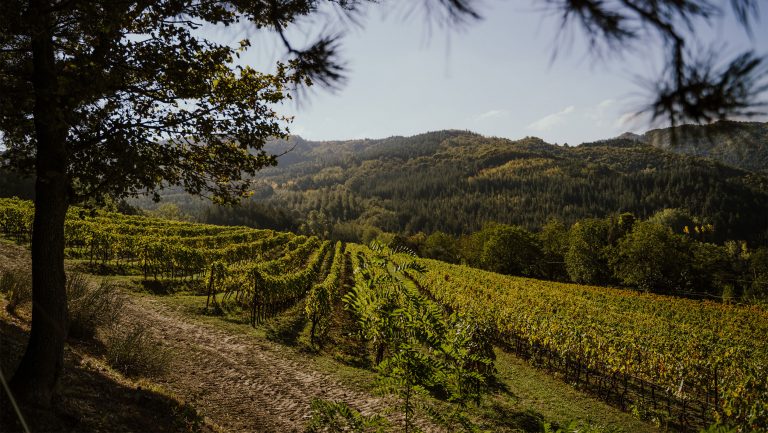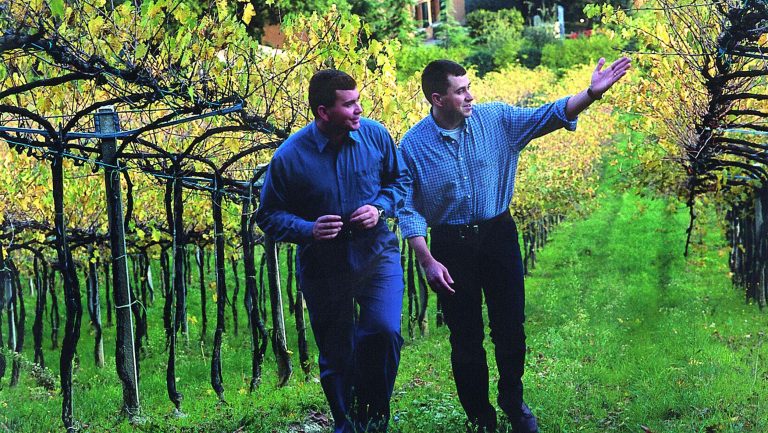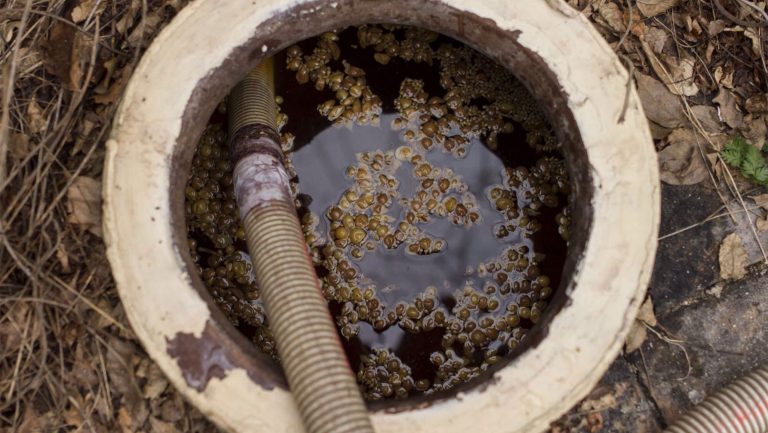Over the past eight years, an exciting new wine initiative has returned Emilia-Romagna to its roots—to its ancient Roman roots, to be precise. Born from a discussion among three Romagnoli wine professionals (while waiting in the daunting Vinitaly restroom line, of all places), ANsomigaFORA is a cultural exchange between Romagnoli and Georgian winemakers.
A play on the Italian word anfora that also means “I am not a fool” in the Romagnolo dialect, ANsomigaFORA is a cultural exchange with Georgian winemakers, who imparted their ancient winemaking techniques to the local vintners. In addition to channeling the region’s winemaking roots, the project has led to the rediscovery of the region’s most important native grapes.
Looking East
Flanked by the Apennine Mountains and the Adriatic Sea, Romagna stretches from southeast of Bologna to Rimini. Today, the latter’s reputation precedes it, the allure of Fellini’s hometown and the Adriatic Riviera often overshadowing the port city’s origins. The Romans founded Rimini in the second century and amphorae wines were among its exports. Before barrels became commonplace, these wines were made from techniques similar to those still practiced by the Georgians.

Don’t miss the latest drinks industry news and insights. Sign up for our award-winning newsletters and get insider intel, resources, and trends delivered to your inbox every week.
“Georgian producers have been making wine the same way for the last 4,000 years. Learning from them is important,” says Carlo Catani, the former director of Slow Food’s University of Gastronomic Sciences in Piedmont. Catani was one of the three Romagnoli wine professionals, along with the late Valter Dal Pane of Osteria della Sghisa, and Mauro Giardini of Villa Venti winery, who were captivated by the Caucasus country’s 8,000-year-old oenological history and UNESCO-protected techniques after a Georgian wine tasting at the 2012 edition of Vinitaly.
Through Slow Food, Catani connected with Ramaz Nikoladze of Nikoladzeebis Marani winery in Imereti, Georgia, who helped expedite the qvevri for ANsomigaFORA. Born as a collective, ANsomigaFORA is now part of Tempi di Recupero, an association dedicated to food recovery and sustainability co-founded by Catani, its current president. He acts as the middleman between the local vintners and Georgian qvevri makers.
“It’s a historical and cultural project related to the Georgian qvevri. They were used here before barrels, so it takes us back to our roots, and doing this is a really beautiful thing.” – Mauro Giardini, Villa Venti
Sourcing Italian or Spanish amphorae might have seemed more practical, but Georgian amphorae were part and parcel of the project. “Qvevri are made the same way they’ve been made for 4,000 years,” says Francesco Bordini of Villa Papiano in Forlì-Cesena, who owns 11 of the egg-shaped vessels. “When you ferment very cloudy juice with lots of lees in an amphora, the juice needs a lot of oxygen.” He adds that since Georgian amphorae are shaped over a wood fire with a low flame, the vessels let in more oxygen during fermentation than oven-baked amphorae.
The inaugural 2013 vintage comprised 12 Romagnoli winemakers and one balsamic vinegar producer from Reggio Emilia. “It’s important to us that the project is inclusive,” says Catani. “We wanted to open it up to any winemaker in Emilia-Romagna who wants to participate, so we have only three guidelines: they must use native grapes, there should be no chemical intervention, and the fermentation must be spontaneous with natural yeasts. There are no minimum requirements for maceration.”
Prior to the harvest, the winemakers pooled their funds to fly Nikoladze and his colleagues to Emilia-Romagna; they inspected the vines and terroir, shared their techniques, and sang the traditional polyphonic harvest songs. The occasion culminated in a Georgian-style banquet—attended by the Georgian Ambassador to Italy—at Osteria della Sghisa, the restaurant once owned by Dal Pane. He passed away shortly after ANsomigaFORA’s founding and the vintners dedicated the project to him. Pre-pandemic, the tradition continued with subsequent visits from Georgian winemakers every couple of years.

Rediscovering Albana—and Other Native Grapes
In addition to honoring the region’s Roman roots, ANsomigaFORA has helped restore the region’s foremost white variety to its glory. Bordini explains that Albana, a grape that gives way to fresh golden wines with bright aromas of yellow fruit and flowers, is ideal for amphorae because its thick skin is high in the phenolic molecules that add tannins to red wines.
“Albana is a very important grape for our region,” says Bordini. “It was very popular in Italy until the 1980s, but interest went down over the last 40 years. To us, this says that modern winemaking technology isn’t suitable for Albana.” He believes this is a testament to how a long maceration is necessary for the best expression of the grape.

Brothers David and Vittorio Navacchia of Tre Monti winery in Imola were on board from the outset. They currently own seven amphorae, and today, almost all 5,500 bottles of the complex, deep amber wine sell out in advance.
Moreover, the response to Vitalba has prompted the brothers to rethink how they approach the Vigna Rocca, their standard dry Albana—they now macerate it for 10 days before the stainless steel fermentation. “And so an ancient winemaking method helped us rediscover the most ancient of our grapes,” says David Navacchia.
Villa Papiano’s Terra is Bordini’s first foray into dry Albana. His vineyard in Modigliana sits at an altitude of 480 meters in the Apennines—180 meters above Romagna’s highest Albana plantings. These surroundings beget exceptionally acidic, passito-friendly grapes. But the amphorae have been game changers, yielding a dry Albana that differs from its counterparts, characterized by a lighter hue and notes of white peach, apple, jasmine, and acacia.
At Villa Venti in Forlì-Cesena, Giardini switches things up, choosing the Centesimino grape for A, his first amphora wine. Bright fruit, florals, and spices characterize the indigenous red variety. Yet his daughter Beatrice Giardini explains that their vines sit on north-facing slopes that add a slight minerality, tempering the typical punchiness of the fruit.
Giardini also works with Famoso, an aromatic, thick-skinned grape similar to Muscat and Malvasia that was recovered in the early 2000s. In 2013, he started making Apeyron, a sweet wine fermented in 100-liter amphorae, then transferred to stainless steel before undergoing solera aging. This year, he released the 2020 Scirone, the first-ever vintage of a dry, amphora-made Famoso.
Giardini emphasizes that ANsomigaFORA isn’t just about the wine. “It’s a historical and cultural project related to the Georgian qvevri,” he says. “They were used here before barrels, so it takes us back to our roots, and doing this is a really beautiful thing.”

Gaining Traction and Pressing Ahead
ANsomigaFORA currently has 20 participating wineries and counting. Tenuta Pennita in Forlì-Cesena joined in 2014, releasing an Albana and a Trebbiano Romagnolo-Malvasia blend. In 2017, Giovannini in Imola and Azienda Agricola Baccagnano in Brisighella respectively launched their 8,000 and Piròna labels, both from Albana.
In May 2021, Tenuta Saiano, located in the province of Rimini, released its first amphora label, AMA, made from Grechetto Gentile, a native white grape. Production manager Alex Fulvi says they’re boosting quantity for the 2021 vintage and also experimenting with Trebbiano Romagnolo in two new Georgian amphorae.
As ANsomigaFORA presses ahead, Catani hopes to increase its visibility both domestically and abroad. As most grapes predate modern winemaking and the transition to barrels, was the success of looking to the past inevitable? Well, the amphorae can’t take all the credit.
“The important thing to understand is that the amphora is an instrument,” says Catani. “It doesn’t make good wine. You need good raw materials and good winemakers to do that.”
And that’s the secret to ANsomigaFORA’s success.

Dispatch
Sign up for our award-winning newsletter
Don’t miss the latest drinks industry news and insights—delivered to your inbox every week.
Jaclyn DeGiorgio is a Milan-based food, wine, and travel writer and a food tour guide. She has contributed to La Cucina Italiana, USA Today 10 Best, National Geographic Traveller, Conde Nast Traveler, Olive, and the Houston Chronicle, among other publications. She holds a Level Three certificate from the Wine and Spirits Education Trust. Follow her @jaclyndegiorgio on Instagram or on her blog.






